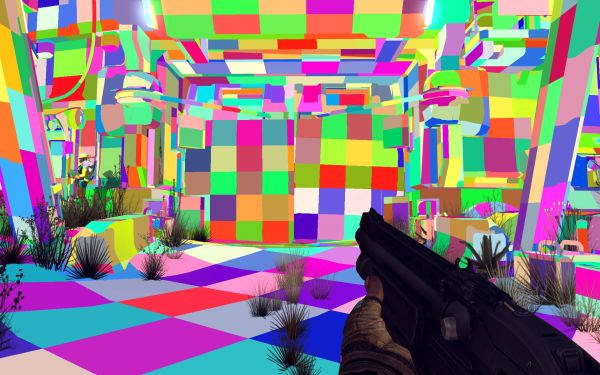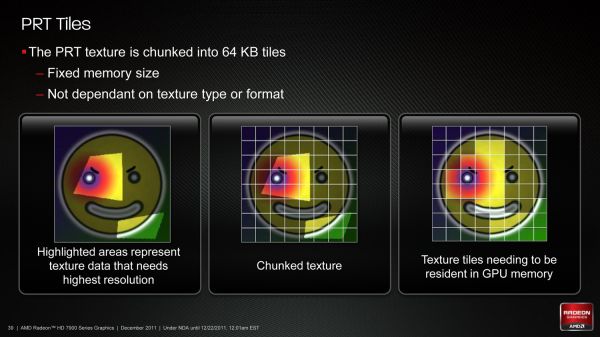AMD Radeon HD 7970 Review: 28nm And Graphics Core Next, Together As One
by Ryan Smith on December 22, 2011 12:00 AM EST- Posted in
- GPUs
- AMD
- Radeon
- ATI
- Radeon HD 7000
Partially Resident Textures: Not Your Father’s Megatexture
John Carmack’s id Software may not be the engine licensing powerhouse it was back in the Quake 3 days, but that hasn’t changed the revolutionary nature of his engine designs. The reason we bring this up is because there’s a great deal of GPU technology that can be directly mapped to concepts Carmack first implemented. For id Tech 4 Carmack implemented shadow volume technology, which was then first implemented in hardware by NVIDIA as their UltraShadow technology, and has since then been implemented in a number of GPUs. For id Tech 5 the trend has continued, now with AMD doing a hardware implementation of a Carmack inspired technology.
Among the features added to Graphics Core Next that were explicitly for gaming, the final feature was Partially Resident Textures, which many of you are probably more familiar with in concept as Carmack’s MegaTexture technology. The concept behind PRT/Megatexture is that rather than being treated as singular entities, due to their size textures should be broken down into smaller tiles, and then the tiles can be used as necessary. If a complete texture isn’t needed, then rather than loading the entire texture only the relevant tiles can be loaded while the irrelevant tiles can be skipped or loaded at a low quality. Ultimately this technology is designed to improve texture streaming by streaming tiles instead of whole textures, reducing the amount of unnecessary texture data that is streamed.
Currently MegaTexture does this entirely in software using existing OpenGL 3.2 APIs, but AMD believes that more next-generation game engines will use this type of texturing technology. Which makes it something worth targeting, as if they can implement it faster in hardware and get developers to use it, then it will improve game performance on their cards. Again this is similar to volume shadows, where hardware implementations sped up the process.
In order to implement this in hardware AMD has to handle two things: texture conversion, and cache management. With texture conversion, textures need to be read and broken up into tiles; AMD is going with a texture format agnostic method here that can simply chunk textures as they stand, keeping the resulting tiles in the same format. For AMD’s technology each tile will be 64KB, which for an uncompressed 32bit texture would be enough room for a 128 x 128 chunk.
The second aspect of PRT is managing the tiles. In essence PRT reduces local video memory to a very large cache, where tiles are mapped/pinned as necessary and then evicted as per the cache rules, and elsewhere the hardware handles page/tile translation should a tile not already be in the cache. Large tomes have been written on caching methods, and this aspect is of particular interest to AMD because what they learn about caching here they can apply to graphical workloads (i.e. professional) and not just gaming.
To that end AMD put together a technology demo for PRT based on Per-Face Texture Mapping (PTEX), a Disney-developed texture mapping technique that maps textures to polygons in a 1:1 ratio. Disney uses this technique for production rendering, as by constraining textures to a single polygon they don’t have to deal with any complexities that arise as a result of mapping a texture over multiple polygons. In the case of AMD’s demo it not only benefits for the reasons that Disney uses it, but also because when combined with tessellation it trivializes vector displacement, making art generation for tessellated games much easier to create. Finally, PRT fits into all of this by improving the efficiency of accessing and storing the Ptex texture chunks.
Wrapping things up, for the time being while Southern Islands will bring hardware support for PRT software support will remain limited. As D3D is not normally extensible it’s really only possible to easily access the feature from other APIs (e.g. OpenGL), which when it comes to games is going to greatly limit the adoption of the technology. AMD of course is working on the issue, but there are few ways around D3D’s tight restrictions on non-standard features.

















292 Comments
View All Comments
Ryan Smith - Thursday, December 22, 2011 - link
Since 1920x1200 has already been commented on elsewhere I'm just going to jump right to your comment on minimum FPS.I completely agree, and we're trying to add it where it makes sense. A lot of benchmarks are wildly inconsistent about their minimum FPS, largely thanks to the fact that minimum FPS is an instantaneous data point. When your values vary by 20%+ per run (as minimums often do), even averaging repeated trials isn't nearly accurate enough to present meaningful results.
CeriseCogburn - Thursday, March 8, 2012 - link
HardOCP shows long in game fps per second charts that show dips and bottom outs are more than one momentary lapse and often are extended time periods of lowest frame rate runs, so I have to respectfully disagree.Perhaps the fault is fraps can show you a single instance of lowest frame rate number, and hence it's the analysis that utterly fails - given the time constraints that were made obvious, it is also clear that the extra work it would take for an easily reasoned and reasonable result that is actually of worthy accuracy is not in the cards here.
thunderising - Thursday, December 22, 2011 - link
Okay. This card has left me thrilled, but wanting for more. Why?Well, for example, every reviewer has hit the CCC Core and Memory Max Limits, which turns into a healthy 10-12% performance boost, all for 10W.
What, legit reviews got it to 1165MHz core and 6550Mhz memory for a 21-24% increase in performance. Now that's HUGE!
I think AMD could have gone for something like this with the final clocks, to squeeze out every last bit of performance from this amazing card:
Core - 1050 MHz
Memory - 1500 MHz (6000MHz QDR)
This was not only easily achievable, but would have placed this card at a 8-10% increase in performance all for a mere <10W rise in Load Power.
Hoping for AIBs like Sapphire to show their magic! HD7970 Toxic, MmmmmmM...
Otherwise, fantastic card I say.
Death666Angel - Friday, December 23, 2011 - link
Maybe they'll do a 4870/4890 thing again? Launch the HD7970 and HD7970X2 and then launch a HD7990 with higher clocks later to counter nVidia.... Who knows. :-)Mishera - Sunday, December 25, 2011 - link
They've been doing it for quite some time now. Their plan has been to release a chip balancing die size, performance, and cost. Then later to compete on high end release a dual-chip card. Anand wrote on this a while ago with the rv770 story (http://www.anandtech.com/show/2679).Even looking at the picture of chip sizes, the 7970 is still a reasonable size. And this really was a brilliant move as though Nvidia has half the marketshare and does make a lot of money from their cards, their design philosophy has been hurting them a lot from a business standpoint.
On a side note, Amd really made a great choice by choosing to wait until now to push for general computing. Though that probably means more people to support development and drivers, which means more hiring which is the opposite way Amd has been going. It will be interesting to see how this dichotomy will develop in the future. But right now kudos to Amd.
CeriseCogburn - Thursday, March 8, 2012 - link
Does that mean amd is abandoning gamers as we heard the scream whilst Nvidia was doing thus ?I don't quite get it - now what nvidia did that hurt them, is praise worthy since amd did it, finally.
Forgive me as I scoff at the immense dichotomy...
"Perfect ripeness at the perfect time" - sorry not buying it....
privatosan - Thursday, December 22, 2011 - link
PRT is a nice feature, but there is an failure in the article:'For AMD’s technology each tile will be 64KB, which for an uncompressed 32bit texture would be enough room for a 4K x 4K chunk.'
The tile would be 128 x 128 texels; 4K x 4K would be quite big for a tile.
futrtrubl - Thursday, December 22, 2011 - link
I was going to comment on that too. A 4k x 4k x 32bit (4byte) texture chunk would be around 67MB uncompressed. For a 32bit texture you could only fit a 128x128 array in a 64KB chunk. An 8bit/pixel texture could be 4k*4kStonedofmoo - Thursday, December 22, 2011 - link
Thanks for the review. A request though...To the hardware sites doing these reviews, many of us in this day and age run dual monitor or more. It always frustrates in me in these reviews that we get a long write up on the power saving techniques the new cards use, and never any mention of it helps those of us running more than one display.
For those not in the know, if you run more than one display on all the current generations the cards do NOT downclock the GPU and memory nearly as much as they do on single montor configurations. This burns quite a lot more power and obviously kicks out more heat. No site ever mentions this which is odd considering so many of us have more than one display these days.
I would happily buy the card that finally overcomes this and actually finds a way of knocking back the clocks with multi-monitor setups. Is the new Radeon 7xxx series that card?
Galcobar - Thursday, December 22, 2011 - link
It's in the article, on the page entitled "Meet the Radeon 7970."Ryan also replied to a similar comment by quoting the paragraph addressing multi-monitor setups and power consumption at the top of page of the comments.
That's two mentions, and the answer to your question.